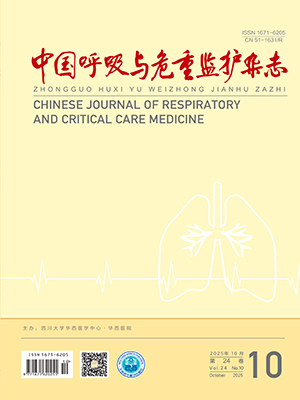| 1. |
Berney S, Denehy L. A comparison of the effects of manual and ventilator hyperinflation on static lung compliance and sputum production in intubated and ventilated intensive care patients. Physiother Res Int, 2002, 7(2): 100-108.
|
| 2. |
Li BG, Martí JD, Comaru T, et al. Short-term appraisal of the effects and safety of manual versus ventilator hyperinflation in an animal model of severe pneumonia. Respir Care, 2019, 64(7): 760-770.
|
| 3. |
Bendixen HH, Hedley-Whyte J, Laver MB. Impaired oxygenation in surgical patients during general anesthesia with controlled ventilation. N Engl J Med, 1963, 269(19): 991-996.
|
| 4. |
Ahmed F, Shafeeq AM, Moiz JA, et al. Comparison of effects of manual versus ventilator hyperinflation on respiratory compliance and arterial blood gases in patients undergoing mitral valve replacement. Heart Lung, 2010, 39(5): 437-443.
|
| 5. |
Diane D, Jacob W, Budgeon C. Ventilator versus manual hyperinflation in clearing sputum in ventilated intensive care unit patients. Anaesth Intensive Care, 2012, 40(1): 142-149.
|
| 6. |
Ukere A, März A, Trepte CJ, et al. Perioperative assessment of regional ventilation during changing body positions and ventilation conditions by electrical impedance tomography. Br J Anaesth, 2016, 117(2): 228-235.
|
| 7. |
Guerin C, Frerichs I. Getting a better picture of the correlation between lung function and structure using electrical impedance tomography. Am J Respir Crit Care Med, 2014, 190(10): 1186-1187.
|
| 8. |
Frerichs I, Hinz J, Herrmann P, et al. Detection of local lung air content by electrical impedance tomography compared with electron beam CT. J Appl Physiol, 2002, 93(2): 660-666.
|
| 9. |
Hinz J, Hahn G, Neumann P, et al. End-expiratory lung impedance change enables bedside monitoring of end-expiratory lung volume change. Intensive Care Med, 2003, 29(1): 37-43.
|
| 10. |
Grant CA, Fraser JF, Dunster KR, et al. The assessment of regional lung mechanics with electrical impedance tomography: a pilot study during recruitment manoeuvres. Intensive Care Med, 2009, 35(1): 166-170.
|
| 11. |
池熠, 何怀武, 袁思依, 等. 电阻抗成像技术监测急性呼吸窘迫综合征患者呼气末正压滴定时局部机械能的临床应用. 中华重症医学电子杂志, 2019, 5(2): 115-119.
|
| 12. |
徐培峰, 金文扬, 应爱芳, 等. 经气切口高流量氧疗呼气末正压效应研究. 中华急诊医学杂志, 2019, 28(12): 1539-1542.
|
| 13. |
Lachmann B. Open up the lung and keep the lung open. Intensive Care Med, 1992, 18(6): 319-321.
|
| 14. |
De Monte V, Grasso S, De Marzo C, et al. Effects of reduction of inspired oxygen fraction or application of positive end-expiratory pressure after an alveolar recruitment maneuver on respiratory mechanics, gas exchange, and lung aeration in dogs during anesthesia and neuromuscular blockade. Am J Vet Res, 2013, 74(1): 25-33.
|
| 15. |
Dennis DM, Duncan CN, Pinder M, et al. Performance of manual hyperinflation: consistency and modification of the technique by intensive care unit nurses during physiotherapy. J Clin Nurs, 2016, 25(15-16): 2295-2304.
|
| 16. |
Tucci MR, Nakamura MA, Carvalho NC, et al. Manual hyperinflation: is it effective?. Respir Care, 2019, 64(7): 870-873.
|
| 17. |
Linnane MP, Caruana LR, Tronstad O, et al. A comparison of the effects of manual hyperinflation and ventilator hyperinflation on restoring end-expiratory lung volume after endotracheal suctioning: a pilot physiologic study. J Crit Care, 2019, 49: 77-83.
|
| 18. |
Savian C, Paratz J, Davies A. Comparison of the effectiveness of manual and ventilator hyperinflation at different levels of positive end-expiratory pressure in artificially ventilated and intubated intensive care patients. Heart Lung, 2006, 35(5): 334-341.
|




